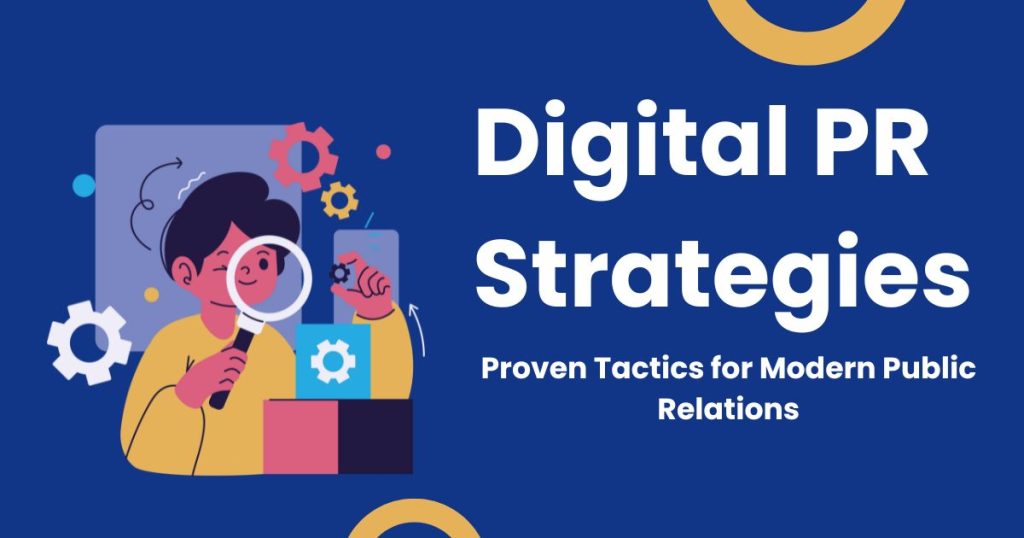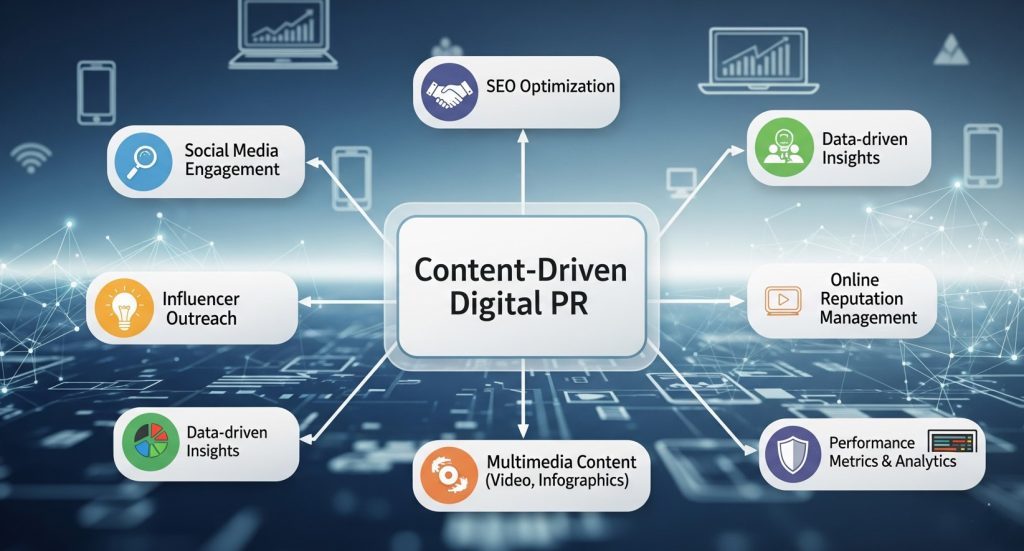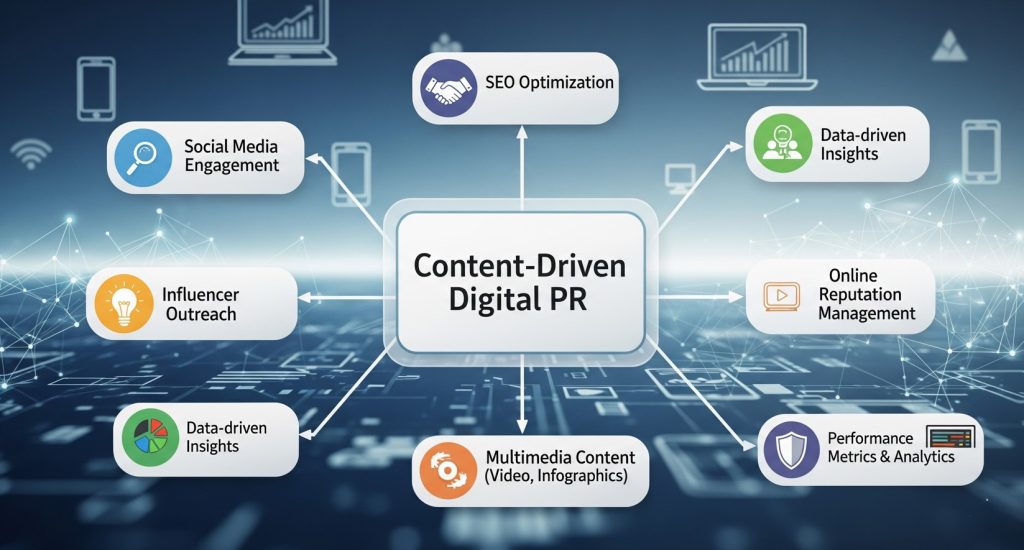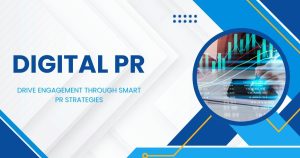Digital PR Strategies That Actually Move the Needle

Digital PR uses media coverage, influencers, and SEO to boost brand visibility, credibility, and online growth by earning attention through valuable content and relationships.
Digital PR has evolved far beyond sending press releases into the void and hoping someone notices. Modern brands need sophisticated approaches that blend traditional public relations with digital marketing tactics to cut through the noise and reach their target audiences effectively.
This comprehensive guide explores proven digital PR strategies that deliver measurable results. You’ll discover how to build meaningful relationships with journalists and influencers, create content that naturally attracts media coverage, and leverage data to demonstrate the real impact of your PR efforts.
Whether you’re a startup seeking your first major media mention or an established brand looking to amplify your digital presence, these strategies will help you build authority, drive traffic, and ultimately grow your business through strategic public relations.
Understanding Modern Digital PR
Digital PR combines traditional public relations tactics with digital marketing strategies to build brand awareness, establish thought leadership, and drive measurable business results online. Unlike traditional PR that focused primarily on print and broadcast media, digital PR encompasses online publications, social media platforms, podcasts, and digital-first media outlets.
The fundamental goal remains the same: earning third-party credibility and exposure for your brand. However, the methods and measurement have evolved significantly. Digital PR practitioners track metrics like domain authority, referral traffic, social media engagement, and search engine rankings alongside traditional metrics like reach and impressions.
This evolution reflects changing media consumption habits. Your target audience likely discovers news and information through social media feeds, online searches, and digital publications rather than traditional newspapers or television broadcasts.
Building Authentic Media Relationships
Success in digital PR starts with cultivating genuine relationships with journalists, bloggers, and content creators who cover your industry. These relationships form the foundation of sustainable PR success. Understanding What Is a Digital PR Agency helps in knowing how agencies support these relationships.

Research and Identify Key Contacts
Start by creating a comprehensive list of media contacts relevant to your industry. Use tools like HARO (Help a Reporter Out), Cision, or Muck Rack to identify journalists who regularly cover topics related to your business. Don’t limit yourself to major publications—niche industry blogs and newsletters often have highly engaged audiences that align perfectly with your target market.
Pay attention to the specific beats each journalist covers and their preferred communication style. Some prefer detailed pitches with supporting data, while others appreciate concise, newsworthy angles.
Provide Value Before Making Asks
The most successful PR professionals understand that relationship-building is a long-term investment. This aligns with the principles in Digital PR Content Marketing Success, showing how providing value enhances credibility.
This approach builds trust and positions you as a valuable resource rather than just another person seeking coverage.
Engage Authentically on Social Media
Follow key journalists on Twitter, LinkedIn, and other platforms where they’re active. Engage thoughtfully with their content by sharing insightful comments or additional context. This organic engagement helps you stay top-of-mind when they’re working on relevant stories.
Content-Driven Digital PR Strategies
Creating content that naturally attracts media attention requires understanding what makes stories newsworthy and shareable. Using AI Tools for Digital PR to Boost Brand Visibility can enhance your content creation efforts.

Develop Data-Driven Stories
Original research and surveys consistently generate media coverage because they provide fresh insights that journalists can reference and build upon. Conduct industry surveys, analyze existing data to uncover trends, or commission research studies that reveal surprising findings about your market.
Present your findings in multiple formats: create infographics for visual learners, write comprehensive reports for in-depth coverage, and develop one-page summaries for time-pressed journalists.
Create Timely and Topical Content
Monitor industry news cycles and current events to identify opportunities where your expertise can add valuable context. Develop a rapid response system that allows you to quickly create and distribute content that ties your brand to trending topics.
This approach requires staying closely connected to your industry’s news landscape and having content creation processes that can move quickly when opportunities arise.
Leverage Storytelling and Case Studies
Transform customer success stories, company milestones, and industry insights into compelling narratives that journalists want to share. Focus on stories that illustrate broader industry trends or challenges that resonate beyond your immediate customer base.
Case studies work particularly well when they demonstrate innovative problem-solving or highlight emerging industry trends that affect a wider audience.
Influencer Collaboration and Partnerships
Digital PR extends beyond traditional media to include partnerships with industry influencers, thought leaders, and content creators who have built trusted relationships with your target audience. Learn more about 7 Digital PR Types That Move the Needle.

Identify Relevant Influencers
Look beyond follower counts to identify influencers whose audiences align with your target market and whose content style matches your brand values. Micro-influencers often deliver higher engagement rates and more authentic connections than mega-influencers.
Use tools like BuzzSumo, Upfluence, or AspireIQ to identify potential partners and analyze their audience demographics and engagement patterns.
Develop Mutually Beneficial Partnerships
Structure influencer partnerships that provide value to both parties and their audiences. This might include collaborative content creation, expert interviews, or co-hosted events that leverage both your expertise and their platform.
The most successful influencer partnerships feel natural and authentic rather than purely transactional.
Measure Partnership Impact
Track the results of influencer collaborations using UTM parameters, dedicated landing pages, or promo codes to understand which partnerships drive the most valuable traffic and conversions.
Crisis Management and Reputation Monitoring
Digital PR strategies must include proactive reputation management and crisis response planning. Understand why Digital PR is Essential for Modern Brand Success in handling crises.
Implement Monitoring Systems
Set up Google Alerts, social media monitoring tools, and media tracking systems to stay aware of mentions of your brand, key executives, and industry topics. Early detection allows you to respond quickly to both positive opportunities and potential issues.
Consider using tools like Mention, Brand24, or Hootsuite Insights for comprehensive monitoring across multiple platforms and media sources.
Develop Response Protocols
Create clear guidelines for how your team should respond to different types of mentions, from positive coverage that you want to amplify to negative comments that require careful handling.
Having pre-approved response templates and escalation procedures helps ensure consistent, appropriate responses even when key team members aren’t immediately available.
Turn Challenges into Opportunities
When faced with criticism or negative coverage, look for opportunities to demonstrate transparency, accountability, and commitment to improvement. Well-handled crisis responses often strengthen rather than damage brand reputation.
Measuring Digital PR Success
Effective measurement requires tracking traditional PR metrics and digital indicators. Businesses can learn from E-Commerce Business Needs a Marketing Agency for connecting efforts to business growth.
Traditional PR Metrics
Continue tracking reach, impressions, and share of voice to understand your brand’s visibility in the media landscape. These metrics help demonstrate the overall exposure your PR efforts generate.
Digital-Specific Measurements
Monitor website traffic from media mentions, domain authority improvements from earned backlinks, and social media engagement generated by coverage. These metrics directly connect PR efforts to digital marketing goals.
Business Impact Indicators
Track lead generation, sales inquiries, and customer acquisition that can be attributed to media coverage. Use UTM parameters and dedicated landing pages to connect PR activities to business results.
Choosing the Right Digital PR Approach

Digital PR success requires a strategic approach that aligns with your business goals, target audience, and available resources. The most effective strategies combine multiple tactics while maintaining consistent messaging and brand positioning across all touchpoints.
Start by focusing on one or two strategies that align most closely with your current capabilities and goals. As you build experience and see results, gradually expand your approach to include additional tactics and platforms.
Remember that digital PR is ultimately about building relationships and providing value. The brands that succeed focus on serving their audiences and supporting journalists rather than just promoting themselves.
Leveraging SEO in Digital PR
One of the most powerful aspects of modern digital PR is its ability to improve search engine visibility. When your brand earns backlinks from authoritative publications, it not only gains credibility with readers but also boosts search engine rankings.
Focus on high-quality backlinks from relevant, reputable sites rather than sheer volume. Collaborate with journalists, bloggers, and industry publications to secure coverage that includes natural, contextual links back to your website. Over time, these backlinks strengthen domain authority, making it easier for your content to rank organically for competitive keywords.
Additionally, consider optimizing press releases and contributed articles for SEO. Include target keywords, meta descriptions, and structured data where appropriate. This dual focus on media coverage and SEO creates a long-lasting digital footprint, ensuring your PR efforts continue to drive traffic long after initial publication.
Integrating Content Marketing and PR
Digital PR and content marketing are complementary disciplines. While PR focuses on earning external coverage, content marketing provides the assets and stories that can be pitched effectively.
Develop a library of high-value content such as case studies, whitepapers, and research reports. These resources serve as anchor pieces for PR campaigns and demonstrate expertise, making your brand more attractive to journalists and influencers.
Additionally, share content internally on your blog, social media, and email newsletters. Coverage from digital PR efforts can then be amplified through owned channels, maximizing visibility and reinforcing your authority in the industry.
Monitoring Competitors and Industry Trends
Effective digital PR involves staying ahead of the curve. Regularly monitor competitors’ media mentions, content strategies, and influencer collaborations. Tools like BuzzSumo, SEMrush, and Mention can help track which types of stories gain traction in your industry.
Understanding what works for competitors allows you to identify gaps and opportunities in your own PR strategy. Whether it’s covering an underreported trend, offering expert commentary on breaking news, or providing unique data insights, proactive monitoring ensures your brand stays relevant and newsworthy.
Building Your Digital PR Foundation
Digital PR represents a fundamental shift in how brands build awareness, establish credibility, and drive business growth. The strategies outlined here provide a comprehensive framework for developing PR efforts that deliver measurable results in an increasingly digital world.
Success requires consistent effort, authentic relationship building, and a commitment to providing value to both media contacts and target audiences. Start with the strategies that best align with your current resources and goals, then gradually expand your approach as you build experience and see results.
The brands that thrive will be those that embrace digital PR as an integrated part of their overall marketing strategy, using earned media and authentic relationships to build trust and drive sustainable growth.
Frequently Asked Questions (FAQ)
How long does it take to see results from digital PR efforts?
Digital PR typically requires 3-6 months of consistent effort before seeing significant results. Relationship building takes time, and media coverage often comes in waves rather than steady streams. However, some tactics like timely commentary on current events can generate immediate coverage.
What’s the difference between digital PR and digital marketing?
Digital PR focuses on earning third-party credibility through media coverage, influencer partnerships, and thought leadership, while digital marketing encompasses paid advertising, social media management, and owned content marketing. Digital PR efforts often support and amplify digital marketing campaigns.
How do I measure ROI from digital PR activities?
Measure digital PR ROI by tracking website traffic from media mentions, lead generation from coverage, improvements in search rankings from earned backlinks, and overall brand awareness metrics. Use UTM parameters and dedicated landing pages to connect PR coverage directly to business results.
Should small businesses invest in digital PR?
Yes, digital PR can be particularly valuable for small businesses because it provides credibility and exposure that would be expensive to achieve through paid advertising. Start with strategies that leverage existing expertise, like providing expert commentary or creating data-driven content.
How long does it take to see results from digital PR campaigns?
Typically, 3–6 months of consistent effort are required. Relationship-building, content creation, and media coverage often occur in waves, with cumulative results over time.
How do I know which influencers or media outlets to prioritize?
Analyze audience alignment, engagement metrics, and relevance to your industry. Micro-influencers and niche publications often yield higher-quality engagement than broad, high-follower accounts.
Can digital PR improve SEO?
Yes. High-quality backlinks from reputable sources improve domain authority, which positively affects organic search rankings. PR content optimized for SEO can also drive long-term traffic to your website.
What is the best way to integrate digital PR with marketing campaigns?
Coordinate messaging across all channels. For example, amplify media coverage through social media, email newsletters, and blog posts. This ensures consistent brand voice and maximizes the impact of earned media.





